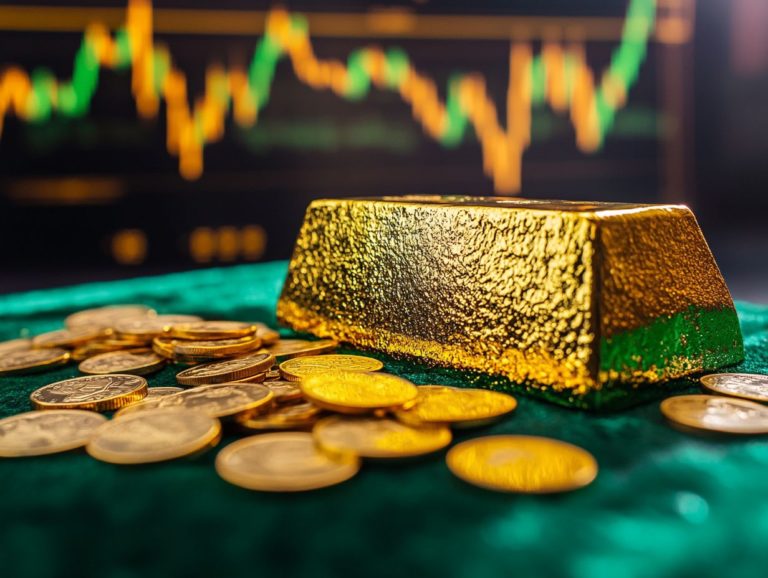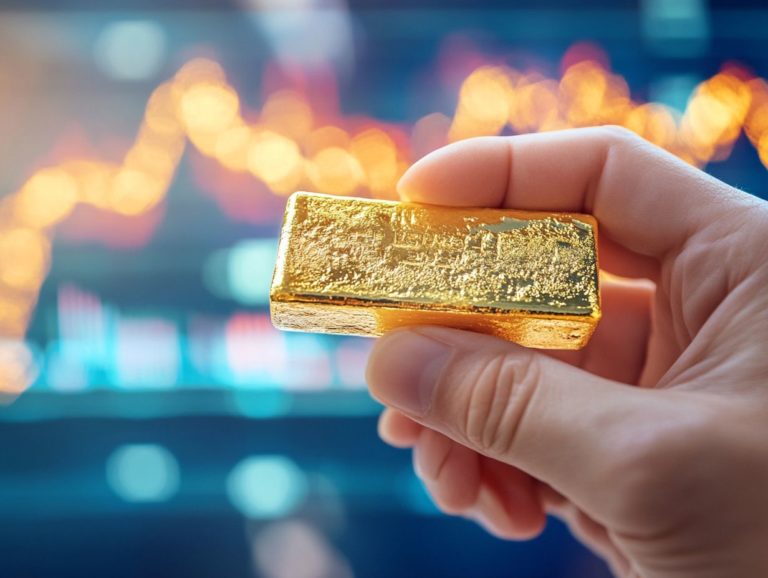Understanding Gold’s Supply and Demand
Gold has always been esteemed as a symbol of wealth and stability, yet the dynamics of its supply and demand are anything but straightforward.
This article delves into the various factors that impact gold’s supply, including mining production and recycling initiatives. It also considers the demand fueled by jewelry, industry, and investment decisions.
You’ll discover how changes in these elements affect gold prices. What might the future hold for this precious metal? Join in as you navigate the intricate landscape of the gold market and uncover its complexities.
Contents
- Key Takeaways:
- Overview of Gold’s Supply and Demand
- What Drives Gold Supply? Discover the Key Factors
- Factors Influencing Gold’s Demand
- Impact of Supply and Demand on Gold Prices
- Gold Supply and Demand: Future Predictions
- Frequently Asked Questions
- What is the concept of supply and demand in relation to gold?
- How does the supply of gold affect its value?
- What factors influence the demand for gold?
- How does mining and production of gold impact its supply?
- What are some common uses for gold?
- How can understanding gold’s supply and demand benefit investors?
Key Takeaways:

- Gold’s supply and demand is influenced by various factors, including mining and production, recycling and scrap supply, jewelry and industrial demand, and investment demand.
- Changes in supply and demand can significantly impact the price of gold, making it a highly volatile commodity.
- The future outlook for gold’s supply and demand is constantly evolving and can be affected by predictions and potential changes in factors such as economic conditions and geopolitical events.
Overview of Gold’s Supply and Demand
The dynamics of gold’s supply and demand are essential in shaping its price, especially during times of rising global economic uncertainty and inflation. The World Gold Council offers valuable insights into the multitude of factors at play, including the policies of central banks and the output of gold mining, which collectively influence the precious metals market.
Variations in jewelry demand and the growing popularity of gold ETFs which stands for Exchange-Traded Funds add layers of complexity to market volatility. For investors like you, understanding these elements is key to protecting your assets from erosion during financial turmoil.
What Affects the Supply and Demand of Gold?
Several factors strongly affect the supply and demand of gold, including economic uncertainty, inflation rates, and central bank activities.
Consider the role of central banks: they significantly sway market dynamics by adjusting their gold reserves. In recent years, many have been net buyers, with central bank purchases reaching an impressive 400 metric tons in 2022 alone.
Inflation plays a critical role in stimulating demand for gold as a hedge against currency depreciation. Recall how inflation rates soared during the global financial crisis of 2008, prompting many to seek refuge in gold.
Gold mining activities further contribute to the overall available supply, but they can be impacted by geopolitical tensions and environmental regulations. Global gold production in 2021 was approximately 3,000 metric tons, reflecting the challenges of maintaining output in a shifting regulatory landscape.
Together, these elements create a complex interplay that ultimately determines the price and availability of gold in the market.
What Drives Gold Supply? Discover the Key Factors
The supply of gold is profoundly influenced by a multitude of factors that you should consider. This includes fluctuations in gold production levels, the intensity of mining activities, and the recycling of gold from previously utilized products.
Together, these elements intricately shape the overall landscape of supply and demand for this precious metal.
Mining and Production
Gold mining and production are crucial elements shaping the supply of gold in the market. These aspects are intricately tied to economic conditions and technological advancements.
You ll find that various gold mining methods such as placer mining, hard rock mining, and by-product mining significantly influence the volume of gold extracted. Leading nations like China, Australia, Russia, and the United States are at the forefront of this industry, collectively responsible for a substantial portion of global gold output.
Economic factors, including gold prices, labor costs, and regulatory changes, can markedly impact production levels, guiding how these countries strategize their mining operations. For instance, in 2021, global gold production hit around 3,000 metric tons, underscoring the enduring significance of this precious metal in maintaining economic stability and attracting investment.
Understanding these factors empowers you to make informed investment choices in the gold market. Consider how these dynamics might impact your investment strategy moving forward.
Recycling and Scrap Supply

Gold recycling is crucial for keeping our gold supply alive and thriving! It enables the recovery of precious metals from old jewelry and electronic waste. This process plays a vital role in maintaining a balance between supply and demand.
Not only does it help reduce the environmental impact of mining, but it also addresses the growing needs of the global jewelry and electronics markets. Recent trends show that approximately 1,000 tons of gold are recycled each year, making up a significant portion of the total available supply.
Factors like rising gold prices and increased consumer awareness of sustainable practices are encouraging more individuals to engage in recycling programs. By choosing recycled gold, you re actively contributing to a circular economy, ensuring that existing resources are used more efficiently.
This choice benefits both the planet and the economy.
Factors Influencing Gold’s Demand
Gold’s demand is influenced by many factors, ranging from the allure of jewelry to its appeal as an investment. Central bank decisions in response to inflation and economic uncertainty significantly shape the market.
Jewelry and Industrial Demand
Jewelry demand is a key player in gold consumption, often swayed by cultural factors and economic conditions that shape your spending decisions.
This intricate relationship is enriched by evolving market trends, particularly the increasing preference for sustainable and ethically sourced materials. Such trends resonate with a growing cohort of conscientious consumers like yourself.
The industrial uses of gold such as electronics and medical devices add another layer to its appeal, extending beyond mere aesthetics.
As these sectors progress, they cultivate a multifaceted demand that mirrors not only personal tastes but also broader technological advancements and cultural transformations.
These dynamics highlight the complexity of the gold market, where your purchasing choices are intricately woven into a tapestry of social and economic influences.
Investment Demand
Investment demand for gold has surged in recent years, driven by economic uncertainty and the growing allure of gold ETFs like SPDR Gold Shares.
This surge in interest shows investors are concerned about market stability and reflects deeper concerns about market volatility and inflationary pressures.
As central banks continue to roll out expansive monetary policies like low interest rates and a method used by central banks to stimulate the economy you may find that many are seeking refuge in safe-haven assets, which hold value in times of uncertainty.
Take 2020, for instance, when global gold demand reached an impressive 4,600 metric tons, a spike largely influenced by the unprecedented economic challenges brought on by the pandemic.
Research indicates that during times of market instability, gold has often outperformed other asset classes, prompting a significant reassessment of portfolio strategies among institutional investors.
Impact of Supply and Demand on Gold Prices
The dynamic relationship between supply and demand profoundly affects the price of gold, especially in the context of market volatility. This interplay shapes both gold production and investment demand.
Understanding this relationship is essential for navigating the complexities of the gold market.
How Changes in Supply and Demand Affect Price

Changes in supply and demand dynamics significantly influence the price of gold. Understanding these market mechanics is essential for effective investment strategies.
Consider the global financial crisis of 2008. During this time, demand for gold surged as investors sought it as a safe-haven asset, driving prices up to nearly $1,000 per ounce. In contrast, in 2013, gold prices fell below $1,200 per ounce when major investors shifted focus to equities, as hopes for economic stability faded. Furthermore, geopolitical events and changing interest rates often intensify these market shifts.
Recently, the situation in Eastern Europe has reignited interest in gold. This demonstrates how external factors can rapidly transform the supply and demand landscape and directly impact valuations. By understanding these trends, you can make more informed investment decisions.
Gold Supply and Demand: Future Predictions
The future outlook for gold’s supply and demand is steeped in uncertainty and shaped by several influential factors. Key considerations include gold production trends, economic fluctuations, and changing consumer preferences, all of which play a pivotal role in this dynamic landscape.
Predictions and Potential Factors for Change
Predictions about gold’s supply and demand will depend on economic conditions, demand fluctuations, and the strategies that central banks adopt in the coming years.
As global economies grapple with challenges like inflation and geopolitical tensions, the relationship between production rates and market appetite for gold will become crucial. Central banks often stabilize uncertain times and may adjust their gold reserves, significantly influencing market dynamics.
Consumer behavior, influenced by evolving investment trends and shifts in industrial applications, will also play a crucial role.
By closely observing how these elements intersect, you ll gain essential insights into the future of gold markets and its appeal as a safe-haven asset.
Frequently Asked Questions
What is the concept of supply and demand in relation to gold?
Supply and demand refer to the relationship between how much gold is available (supply) and how much people are willing to buy (demand). Understanding this balance is crucial in determining the price of gold.
How does the supply of gold affect its value?

A high supply of gold typically means there is an abundance in the market, which can drive the price down. Conversely, a low supply can lead to higher demand and an increase in price.
What factors influence the demand for gold?
The demand for gold can be influenced by various factors, including economic stability, political events, and investor sentiment. In times of economic uncertainty, for example, the demand for gold as a safe-haven asset tends to rise.
How does mining and production of gold impact its supply?
The mining and production of gold play a significant role in its overall supply. When mining companies increase production, the supply rises, potentially affecting prices. A decrease in mining and production can lead to lower supply and possibly drive up prices.
What are some common uses for gold?
Gold has a wide range of uses, including jewelry, electronics, and currency. It also serves as a store of value and a hedge against inflation.
How can understanding gold’s supply and demand benefit investors?
By understanding the supply and demand dynamics of gold, investors can make more informed decisions about when to buy and sell. This knowledge also helps them better grasp market trends and predict future price movements.















